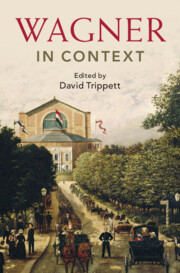Book contents
- Wagner in Context
- Composers in Context
- Wagner in Context
- Copyright page
- Contents
- Illustrations
- Musical Examples
- Contributors
- Acknowledgements
- Abbreviations
- Introduction
- I Place
- II People
- III Politics, Ideas, and Bodies
- IV Life, Language, and the Ancient World
- V Music and Performance
- VI Reception
- Chapter 35 Regietheater in Performance
- Chapter 36 Twentieth-Century Reception and Anti-Semitism
- Chapter 37 Bayreuth as Idea: Chamberlain, Wolzogen, Hitler
- Chapter 38 Performing Wagner in Israel: An Affront or a Tribute?
- Chapter 39 Nineteenth-Century Music Criticism
- Chapter 40 Wotan’s Stormtroopers and the Total Art Machine: Kittler’s Ring of the Nibelung
- Chapter 41 Sound Recording
- Chapter 42 The Wagnerian Erotics of Video Game Music
- Further Reading
- Select Bibliography
- Index
Chapter 35 - Regietheater in Performance
from VI - Reception
Published online by Cambridge University Press: 14 March 2024
- Wagner in Context
- Composers in Context
- Wagner in Context
- Copyright page
- Contents
- Illustrations
- Musical Examples
- Contributors
- Acknowledgements
- Abbreviations
- Introduction
- I Place
- II People
- III Politics, Ideas, and Bodies
- IV Life, Language, and the Ancient World
- V Music and Performance
- VI Reception
- Chapter 35 Regietheater in Performance
- Chapter 36 Twentieth-Century Reception and Anti-Semitism
- Chapter 37 Bayreuth as Idea: Chamberlain, Wolzogen, Hitler
- Chapter 38 Performing Wagner in Israel: An Affront or a Tribute?
- Chapter 39 Nineteenth-Century Music Criticism
- Chapter 40 Wotan’s Stormtroopers and the Total Art Machine: Kittler’s Ring of the Nibelung
- Chapter 41 Sound Recording
- Chapter 42 The Wagnerian Erotics of Video Game Music
- Further Reading
- Select Bibliography
- Index
Summary
Since the arrival of Regietheater in opera, beginning in the 1970s, the possibilities, limits, and demands of stage directing in opera have been a topic of debate. Regietheater both maintains opera’s musical dramaturgy and radically questions, re-examines, and recontextualises the transmitted and ascertainable strata of meaning in the available texts (libretto, score, discourse on the staging history). By discussing some exemplary moments and striking characteristics of Regietheater productions of the Wagnerian repertoire (e.g., by Harry Kupfer, Peter Konwitschny, Katharina Wagner), the chapter argues that such productions are necessary for keeping the well-known repertoire alive. The chapter is not meant as an overview of current staging practices of the Wagnerian repertoire, nor as a best-of list for Regietheater productions; it is rather an attempt to highlight some of the possible effects of those productions.
- Type
- Chapter
- Information
- Wagner in Context , pp. 355 - 363Publisher: Cambridge University PressPrint publication year: 2024

